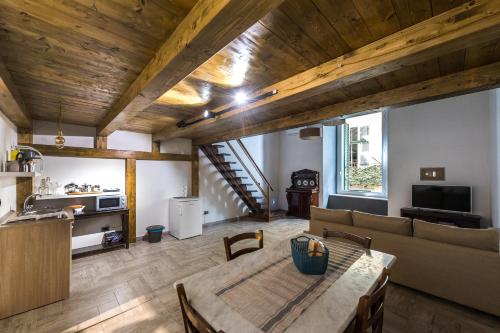The Ancient Greeks had a bit of a different approach to colonisation than the Ancient Romans. The Romans used armies and politics to claim new land, gradually expanding their empire around the world.
The Greeks, on the other hand, were relatively happy to just the rule the city-states they already had and form relationships with other ones in the region. They saw the expansion of their empire not in terms of land, but in terms of wealth and knowledge.
Yet, during the peak of the Ancient Greek civilisation, its citizens set out to form dozens of new colonies around the Mediterranean. This wasn’t part of a grand expansionist policy… so why were these Ancient Greek colonies formed?
Well, it was generally one of two main reasons.
The first was that some people needed to flee their homes in Greece and create a new community to live in. This was usually because of a political disagreement or a similar kind of conflict – a coup attempt gone wrong, for example, or a falling out of favour with the ruler.
The second was for economic opportunities. People from Greece who saw the potential profit in trade would establish new commercial centres in foreign countries to make the most of this.
One of these such colonies was Paestum (originally called Poseidonia), which was founded on the coast of Italy, just south of modern-day Naples.
Today, it has become an important archaeological park and has been listed as a World Heritage Site. But visiting Paestum is about discovering more than just the Ancient Greek history – it’s also about what these settlements meant for the Roman Empire.
What is Paestum?
Paestum was a city founded in about 600 BC on the Italian coast south of Naples by Ancient Greek settlers. While most of the city is in ruins, its temples have survived relatively intact and are the highlight of the archaeological site today.
Why is Paestum so significant?
The temples at Paestum are considered to be some of the best-preserved Ancient Greek temples in the world, including in Greece itself! Along with the surrounding Cilento region, Paestum has been listed as a World Heritage Site.
Is it worth visiting Paestum?
Paestum is an excellent day trip from Naples and is worth a visit. As well as the incredible temples and artwork in the museum, visiting Paestum is also an opportunity to see the Cilento region, including the Vallo di Diano National Park .
Paestum is now one of the best day trips from Naples if you’re looking for something a bit different from the usual attractions.
It’s relatively easy to visit Paestum from Naples, the Amalfi Coast, or from nearby Salerno. I’ll go into some of those details about how to get to Paestum shortly. But first, let’s have a look at how it came to be.
The history of Paestum
It’s thought the founders of Paestum came from a city called Sybaris, which was in what is now the southern Italian region of Calabria.
When they got to this spot, they actually called their new city Poseidonia, with the name later changed by the Romans to Paestum (which it is still called today).
Pasetum was probably founded around 600 BC but it’s unclear if it was for economic reasons or if the original citizens were refugees.
The archaeological evidence does show that the city grew quickly, with roads and public buildings, coins, and art.
And, of course, Paestum had one of the most important elements of a urban centre of that period – temples – which are the highlights these days.
The city of Paestum changed hands numerous times in the centuries after its founding – first from the Ancient Greeks, to an indigenous culture called the Lucanians, and then the Romans.
Gradually, though, it lost its standing as a trading post as the mouth of the nearby Silarus River silted up, meaning boats couldn’t come in (and it became a breeding ground for malarial mosquitos!).
Paestum was completely abandoned in 871 AD and the remains weren’t rediscovered until the 18th century
Things to see at Paestum
Like other Greek colonies, the settlers built impressive temples dedicated to the ancient gods. What makes the ones at Paestum so special is that they still exist in extremely good condition.
In fact, the temples at Paestum are almost the best preserved Ancient Greek temples in the world – and that includes in Greece itself!
One of the main reasons I would recommend visiting Paestum from Naples is to see these temples. They have been designated as a World Heritage Site and, even in a region with a lot of remarkable sights, Paestum holds its own (even if it doesn’t have nearly the same number of tourists as places like Pompeii or Mount Vesuvius).
There are three main temples that you’ll find at Paestum.
First Temple of Hera at Paestum
This is the oldest of the three temples and was probably built around 550 BC. It was dedicated to Hera, the goddess of women, marriage, family, and childbirth.
The architecture is actually a bit unusual because it’s wider than normal and has a different amount of columns than you would normally find in Greek temples from this period.
You can walk inside it and get a sense of the scale as you stand amongst the columns, which have a very strong curve in their design. If you look closely, you can even see a few traces of the original paint.
Second Temple of Hera at Paestum
Adjacent is a second temple dedicated to Hera, this one built around 450 BC. There is, however, a bit of confusion about whether the temple was also dedicated to Poseidon, and some experts call it ‘The Temple of Poseidon at Paestum’.
It’s a large temple and you can walk inside this one too. The different rows of columns form beautiful lines of sight as you move throughout the central area.
Temple of Athena
At the other end of the site, you’ll find the Temple of Athena. It was built in 500 BC and is the smallest of the three temples here at Paestum. The architecture is described by experts as ‘transitional’, meaning it shows influences of both the Ionic and early Doric styles.
You can’t go inside this temple but it is a peaceful part of the city and a nice spot to have a rest. By the time I get here, I’ve walked through the remains of the old city and I’m ready for a rest. Seats in the shade of large trees offer the perfect opportunity.
Paestum Museum
Another pleasant surprise is the Paestum Museum that’s near the entrance to the site. The museum has displays with excellent explanations of the history of the site and a very good collection of artefacts that have been found during excavations.
Although there’s lots to see in the museum, the most important part is the ‘Tomb of the Diver’.
It is an incredible painted tomb that is from the Ancient Greek period and dated around 470 BC (there are other painted tombs in the area, but they are from much later).
It is called the ‘Tomb of the Diver’ because of the painted ceiling of the tomb that shows a young man diving into water, a symbol of passing into the afterlife. But one of the other fascinating parts are the painted scenes on the walls of the tombs that show social scenes and homosexual lovers.
If you’re going to Paestum, make sure you give yourself enough time to see the museum properly (I would suggest an hour).
Visiting Paestum
I tend not to do too much research before coming to World Heritage Sites. I’ll do some reading to understand the significance of the site and know what particular highlights to look out for – but I don’t want to hear other people’s opinions or reviews.
I like to make up my own mind without any preconceived ideas.
I was expecting the Paestum temples to be a bit underwhelming. In fact, I originally had a plan to catch a return train about 90 minutes after I arrived – but in the end I stayed for many more hours.
There is a combination of two general things that I thought made Paestum an enjoyable visit.
The first was the excellent state of preservation that the temples are in. You’re never going to find something that’s 2500 years old in a perfect condition, but these come the closest you’ll find around the world (certainly better than more famous places like the Acropolis or Aphrodisias).
And the second is the access that you get to the structures. I love that you can walk up into the two largest temples, stand in the middle, or slide between the columns. You can really appreciate the way it as constructed and the delicate design balances
You can visit Paestum from Naples independently, and I’ve got some info about that further on. But you’ll get a lot more out of your visit with a guided tour (and they will take the hassle out of the logistics).
The best option (which is also great value) is this small-group guided tour. Alternatively, I would recommend this private tour. Note, though, neither includes transportation.
You can see all the tour options here:
Although I enjoyed walking around the site by myself, there is not much information on display. You would certainly benefit from having a guide.
If you would prefer to visit Paestum independently, I’ve got some information below to help you plan your day.
Where is Paestum?
Paestum is about 90 kilometres southeast of Naples and 300 kilometres southeast of Rome. The official address of the Archaeological Park of Paestum is Via Magna Graecia, 917/919, 84047 Paestum SA, Italy.
You can see it on a map here.
How do you get to Paestum from Naples?
It is quite easy to get to Paestum from Naples by public transport. You can take a direct Trenitalia train from Naples to the stop called Paestum (it will take about 1h10m). From the train station, it is a short 10 minute walk to the site.
But if you’re coming by train from Naples, you need to be aware that there are very few return options during the middle of the day. Check the timetable in advance to make sure you don’t either have too little or too much time in Paestum.
Or, you can get a private transfer from Naples which will be more expensive but much more comfortable (and decent value, if there are a few of you).
When is Paestum open?
The Paestum Archaeological Park and Paestum Museum are open every day from 08:30 to 19:30 in April to June, and 8:30 – 17:00 in November to March, except Christmas Day and New Year’s Day.
On the first and third Mondays of each month, the museum closes at 13:40.
The last admission is 40 minutes before closing time.
How much does it cost to visit Paestum?
A ticket to the Archaeological Park of Paestum includes admission to the Paestum Museum as well as the archaeological site at Velia (and is valid for 3 days).
From March to November, it costs €15 for full admission and €2 for concession.
From December to February, it costs €10 for full admission and €2 for concession.
Entry is free for under 18s.
Are there tours to Paestum?
The best option to learn more about the site (which is also great value) is this small-group guided tour. Alternatively, I would recommend this private tour. Note, though, that neither includes transportation.
Although it’s easy to get the train from Naples to Paestum, the timetable is slightly irregular and doesn’t necessarily match up with how long you would want to spend at the site. I would recommend checking the times here in advance so you can plan your return and not get caught at the site for too long.
Make sure you leave time for the archaeological museum – there are lots of really interesting exhibitions to see.
If you are hungry, there are a few decent restaurants near the site (not at the train station, though).
For more information, you can visit Paestum’s official website.
I would suggest using Naples as a base to explore Paestum and some of the other great historical sites in the region. If you need accommodation, I’ve got some great suggestions:
THE BEST ACCOMMODATION IN NAPLES
I’ve got lots of tips about where to stay in Naples in another article or have a look at some of the highlights below.
BACKPACKER

The bunk beds are fairly standard, but Tric Trac Hostel has a fun modern feel and a great breakfast.
APARTMENT

A large apartment with a cool design, Casa Calu makes a great base if you’re staying a while
BOUTIQUE

Like an oasis in the middle of the city, Costantinopoli 104 is set within a gorgeous 19th-century villa with a pool.
LUXURY

It doesn’t get much more luxurious than the Britannique Hotel, with fabulous suites and panoramic views.
Thank you for sharing your wonderful list of Geek temples with us!
Wow.. I didn’t know about Paestum. It looks amazing in your post. You captured awesome photographs of these places. I would love to visit these places in future.
Such a great detail and article you write up! What a fantastic photographs you shared… Thank you so much for sharing this post and experiences.
How many hours do you reccomend for a visit?
I would recommend 2-3 hours, including the museum. The site itself is not enormous so you can cover the ground relatively quickly – but because you can walk up into the larger temples, I would recommend taking your time to explore it properly.
Hello,
I am looking to visit the Campania region next year and stumbled across your blog post. I am looking to visit Paestum again and loved reading your description and advice about visiting. Will explore your site more.
Thanks, Brendan
We visited Paestum in July. It really is a beautiful place. We loved that it wasn’t as busy or expensive as Pompeii. Being able to explore inside these magnificent temples was awesome. Highly recommend you visit here. We stayed in Salerno which is an awesome location for a homebase for Naples, Amalfi etc.
We visited Paestum in the mid 60s, It was just an overgrown site. However, the magnificence of the ruins could be appreciated and much more so now that we have also visited the various Greek ruins in Sicily. There was no museum and certainly no infrastructure in the town.
I visited Paestum in the late 1970s.
Got off at the small train station and walked to the temple ruins. Hardly anyone there that day. It was peaceful and beautiful and I was so impressed by the temples…just about the best-preserved Greek temples I’ve seen.
I highly recommend a visit. I imagine there may be more amenties now (2023), but part of the charm when I visited was the accessibility of the ruins and the peacefulness of the spring day.
I’ve never forgotten that afternoon. One of the unexpected highlights of my travels.